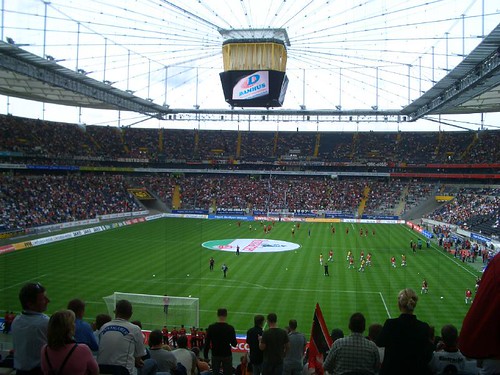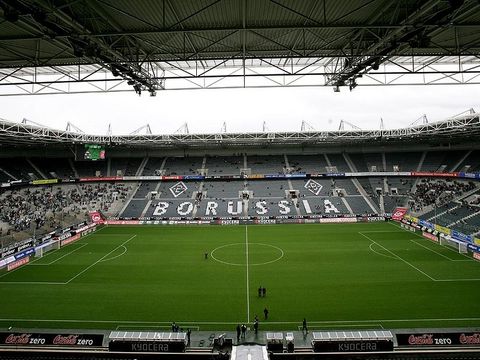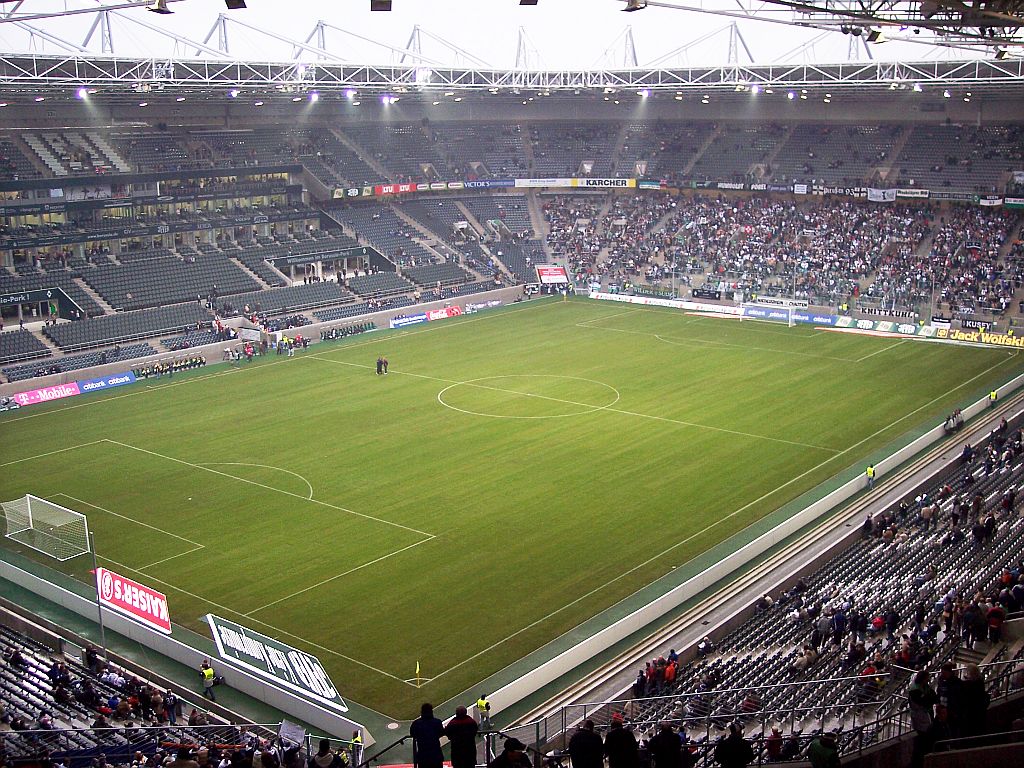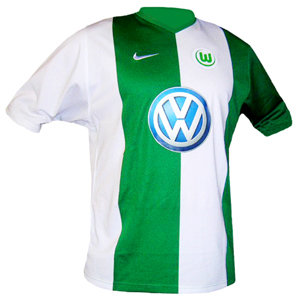The Frankfurt Stadium in was formerly built as the Waldstadion in 1925. Among the national socialists in the thirties, the Waldstadion was also used for political meetings such as deployments and assemblies, with up to 150,000 participants.
Frankfurt 2011
Federal state: Hessen
Population: 662 000
Area: 248 km²
Rivers: Main, Nidda
Location: 50° 07' N 08° 41' O
History
The first recorded mention of Frankfurt dates from an imperial assembly and church synod presided over by Charlemagne in 794. Situated at the crossroads of numerous European trade routes, Frankfurt began to emerge as one of the continent's most important trade and finance centres in the Middle Ages. Jewish sources dating from 1150 report on (autumn) fairs in Frankfurt.
In 1329, the Emperor Ludwig granted the city a second annual fair. From 1330 onwards, the spring fair became a hub for the continent's nascent import-export trade. Emperor Charles lV's Golden Bull confirmed Frankfurt as the location for the election of German kings. From 1562, Frankfurt supplanted Aachen as the city where Emperors were crowned. The city was capital of the German Confederation from 1816 until 1866, and the first freely elected German parliament convened in St Paul's Church in 1848-9. Frankfurt was extensively damaged in the Second World War, with the Old Town practically obliterated.

In 1949, Chancellor Konrad Adenauer narrowly prevailed with his choice of Bonn as capital of the new Federal Republic ahead of Frankfurt, which had even constructed a parliament building for the purpose. The building now houses the local state broadcaster. After many years of acrimonious debate, skyscrapers have become the defining element of the modern city. Alongside the Romer Town Hall, the skyline is the city's symbol and trademark. Frankfurt rates as a leading international finance and business centre, and boasts branches of more than 490 domestic and foreign banks, including the headquarters of Deutsche Bank and the European Central Bank. The ECB will move to a new skyscraper in the east of the city in 2012.

Portrait
The usual top-of-mind associations with Frankfurt are the airport, St Paul's church, Goethe, the German stock exchange, the Book Fair, skyscrapers - and sausages. The city offers a fascinating mix of opposites, a buzzing global crossroads combined with the charm of a village. Internationalism is Frankfurt's leitmotiv: almost a third of the citizens hail from outside Germany, but many districts remain homely to the point of introversion.

The half-timbered houses, narrow alleyways and timeless pubs of Sachsenhausen or Hochst, serving the locals' favourite Ebbelwoi or apple wine, conjure up something close to a rural idyll. However, big business is omnipresent in the banking quarter and the airport. The finance and insurance industries employ 70,000 staff. Just 12 kilometres outside the centre, another 70,000 or more work as civil servants, security personnel and retail staff at the airport, Germany's single biggest centre of employment.

Frankfurt is a globally significant trade fair and exhibition centre. The leading events include the Book Fair, first held in the 15th century, the IAA motor show, and Ambiente, the world's biggest consumer durables fair. The jewel in the city's cultural crown is Museumsufer, a series of outstanding museums ranged along the riverbank. Frankonovurd, the original name of the settlement, means ford of the Franks, indicating a section of the River Main shallow enough in medieval times to be crossed by wading.

Romerberg square and the 14th century Town Hall form the heart of the Old Town. By contrast, the unique skyline has prompted the nickname 'Mainhattan'. The Messeturm was the tallest building in Europe at 257 metres on completion in 1990, only to be supplanted seven years later by the 300-metre tall Commerzbank Tower. Plans are in place for further skyscrapers to shape the ever-modern skyline.

Sights:
Cathedral
St Paul's church
Stadel Museum
Alter Oper opera house
Palmengarten botanical gardens

Football
Frankfurt rates as the capital of German sport, home to leading organisations such as the German Football Association (DFB) and the German Olympic Sports Federation (DOSB). The citizens and their guests from all over the world will never forget the extraordinary atmosphere before, during and after the city's five 2006 FIFA World Cup™ matches at the Frankfurt Arena.

Frankfurt also staged five matches at the 1974 finals, including the Opening Match between Brazil and Yugoslavia, and a legendary battle in torrential rain between Germany and Poland. The stadium was also a venue for the 1988 UEFA European Championship and FIFA Confederations Cup 2005, including the Opening Match and the Final between Brazil and Argentina.

Eintracht Frankfurt boast one of the richest histories in German club football. Eintracht celebrated their greatest triumphs in winning the 1959 German championship and the 1980 UEFA Cup. Local heroes include 1974 FIFA World Cup winners Bernd Holzenbein and Jurgen Grabowski, and "Charly" Korbel, whose 602 appearances are a Bundesliga record. FFC Frankfurt have utterly dominated the Women's Bundesliga for many years, winning the league and Cup seven times apiece, and the UEFA Cup thrice. Far and away the country's most successful women's club, FFC Frankfurt have nurtured greats of the domestic and international game including Birgit Prinz, Steffi Jones and Silke Rottenberg.

Population: 662 000
Area: 248 km²
Rivers: Main, Nidda
Location: 50° 07' N 08° 41' O
History
The first recorded mention of Frankfurt dates from an imperial assembly and church synod presided over by Charlemagne in 794. Situated at the crossroads of numerous European trade routes, Frankfurt began to emerge as one of the continent's most important trade and finance centres in the Middle Ages. Jewish sources dating from 1150 report on (autumn) fairs in Frankfurt.
In 1329, the Emperor Ludwig granted the city a second annual fair. From 1330 onwards, the spring fair became a hub for the continent's nascent import-export trade. Emperor Charles lV's Golden Bull confirmed Frankfurt as the location for the election of German kings. From 1562, Frankfurt supplanted Aachen as the city where Emperors were crowned. The city was capital of the German Confederation from 1816 until 1866, and the first freely elected German parliament convened in St Paul's Church in 1848-9. Frankfurt was extensively damaged in the Second World War, with the Old Town practically obliterated.

In 1949, Chancellor Konrad Adenauer narrowly prevailed with his choice of Bonn as capital of the new Federal Republic ahead of Frankfurt, which had even constructed a parliament building for the purpose. The building now houses the local state broadcaster. After many years of acrimonious debate, skyscrapers have become the defining element of the modern city. Alongside the Romer Town Hall, the skyline is the city's symbol and trademark. Frankfurt rates as a leading international finance and business centre, and boasts branches of more than 490 domestic and foreign banks, including the headquarters of Deutsche Bank and the European Central Bank. The ECB will move to a new skyscraper in the east of the city in 2012.

Portrait
The usual top-of-mind associations with Frankfurt are the airport, St Paul's church, Goethe, the German stock exchange, the Book Fair, skyscrapers - and sausages. The city offers a fascinating mix of opposites, a buzzing global crossroads combined with the charm of a village. Internationalism is Frankfurt's leitmotiv: almost a third of the citizens hail from outside Germany, but many districts remain homely to the point of introversion.

The half-timbered houses, narrow alleyways and timeless pubs of Sachsenhausen or Hochst, serving the locals' favourite Ebbelwoi or apple wine, conjure up something close to a rural idyll. However, big business is omnipresent in the banking quarter and the airport. The finance and insurance industries employ 70,000 staff. Just 12 kilometres outside the centre, another 70,000 or more work as civil servants, security personnel and retail staff at the airport, Germany's single biggest centre of employment.

Frankfurt is a globally significant trade fair and exhibition centre. The leading events include the Book Fair, first held in the 15th century, the IAA motor show, and Ambiente, the world's biggest consumer durables fair. The jewel in the city's cultural crown is Museumsufer, a series of outstanding museums ranged along the riverbank. Frankonovurd, the original name of the settlement, means ford of the Franks, indicating a section of the River Main shallow enough in medieval times to be crossed by wading.

Romerberg square and the 14th century Town Hall form the heart of the Old Town. By contrast, the unique skyline has prompted the nickname 'Mainhattan'. The Messeturm was the tallest building in Europe at 257 metres on completion in 1990, only to be supplanted seven years later by the 300-metre tall Commerzbank Tower. Plans are in place for further skyscrapers to shape the ever-modern skyline.

Sights:
Cathedral
St Paul's church
Stadel Museum
Alter Oper opera house
Palmengarten botanical gardens
Football
Frankfurt rates as the capital of German sport, home to leading organisations such as the German Football Association (DFB) and the German Olympic Sports Federation (DOSB). The citizens and their guests from all over the world will never forget the extraordinary atmosphere before, during and after the city's five 2006 FIFA World Cup™ matches at the Frankfurt Arena.

Frankfurt also staged five matches at the 1974 finals, including the Opening Match between Brazil and Yugoslavia, and a legendary battle in torrential rain between Germany and Poland. The stadium was also a venue for the 1988 UEFA European Championship and FIFA Confederations Cup 2005, including the Opening Match and the Final between Brazil and Argentina.

Eintracht Frankfurt boast one of the richest histories in German club football. Eintracht celebrated their greatest triumphs in winning the 1959 German championship and the 1980 UEFA Cup. Local heroes include 1974 FIFA World Cup winners Bernd Holzenbein and Jurgen Grabowski, and "Charly" Korbel, whose 602 appearances are a Bundesliga record. FFC Frankfurt have utterly dominated the Women's Bundesliga for many years, winning the league and Cup seven times apiece, and the UEFA Cup thrice. Far and away the country's most successful women's club, FFC Frankfurt have nurtured greats of the domestic and international game including Birgit Prinz, Steffi Jones and Silke Rottenberg.

Monchengladbach 2011
Federal state: Nordrhein-Westfalen
Population: 265 000
Area: 170 km2
Rivers: Gladbach, Niers, Schwalm
Location: 51° 12' N 06° 26' E

History
Monchengladbach, located west of the Rhine between Dusseldorf and the Dutch town of Roermond, only assumed its current boundaries on 1 January 1975 after local government reforms. The reorganisation merged the communities of Monchengladbach, Rheydt and Wickrath into one administrative unit, the former being the biggest of the three with just short of 140,000 inhabitants.
The first settlements in the Monchengladbach area date back approximately 300,000-400,000 years. Numerous cairns from the Neolithic and the Bronze Age still exist today. The history of Monchengladbach began with the construction of Gladbach Cathedral and the founding of an abbey in the year 974 by Gero, Archbishop of Cologne, and the monk Sandrad of Trier.
French revolutionary troops marched into the town in October 1794. From 1798 until 1814, the Mairie Gladbach was annexed to the French Département de la Roer, before becoming part of the Kingdom of Prussia in 1815.

The name Monchengladbach has undergone any number of mutations since 1085. Historians are aware of at least 20 variations of Gladbach, and countless forms of the Middle Low German version Monchgladbach, and the Middle High German Munchen Gladbach.
The Rheindahlen Military Complex, housing NATO's northern HQ and the headquarters of the British Army of the Rhine, was constructed from 1952 to 1954. The complex, including staff offices, barracks, supply facilities und residential blocks, forms a small British town with street names in English within the Monchengladbach city limits.

Portrait
Monchengladbach lies at the heart of the left side of the Lower Rhine region, some 16 kilometres from the river. It is characterised by an attractive blend of urban flair and rustic charm, and is known as "the big city in the country" for its plentiful parks and forests.
The visitor attractions span a period of more than 800 years. The oldest historic building is the Minster on the Abteiberg from the 12th-13th centuries. The Abteiberg Museum, designed by Hans Hollein, is a classic of contemporary city centre architecture. The districts outside the old city centre offer castles, stately homes, estates and traditional villages.
Once a traditional single-industry town almost exclusively devoted to the textile and clothing industries, Monchengladbach has evolved over the last three decades into a flexible commercial centre with a balanced mix of trades. Only seven percent of the workforce is employed in textiles and clothing these days. The city's commercial development plan envisages a five-pillar model comprising textiles and fashion, mechanical engineering, electronics, logistics, and healthcare/medical technology.
Monchengladbach boasts the oldest horse trotting track in Germany. The earliest ancestor of the current racing club, the Verein zur Förderung der Traberzucht des Niers-Nordkanal-Bezirks, was founded back in 1893. According to the Guinness Book of Records, Monchengladbach is the only city in Europe with two main railway stations, Monchengladbach Hbf and Rheydt Hbf.

Celebrating the pre-Lent carnival has long been a Monchengladbach tradition, with the festivities coming to a head in the Veilchendienstag (Violet Tuesday) parade. Famous footballers such as Gunter Netzer and Jupp Heynckes are sons of the city. Film-maker Heinz Sielmann, sports reporter Kai Ebel, and Miss World 1956 Petra Schurmann also hail from the Lower Rhine.
Sights:
Rheydt Castle
Abteiberg Museum
Minster-Basilica of St Vitus
Bunter Garten
Water Tower
Football
Borussia Monchengladbach is a name which resonates around the footballing world. In the 1970s, the "Foals" won the hearts of many a neutral for providing stubborn resistance to the might of Bayern Munich. Borussia claimed five Bundesliga titles and won the UEFA Cup on two occasions, affording coach Hennes Weisweiler the status of a legend. However, despite moving to the magnificent new Borussia Park in 2004, Gladbach were relegated to the second division in 2007. Apart from local boys Netzer and Heynckes, a long list of greats includes Rainer Bonhof, Horst Koppel, Herbert Wimmer, Lothar Matthaus, Uli Stielike and Berti Vogts.

Population: 265 000
Area: 170 km2
Rivers: Gladbach, Niers, Schwalm
Location: 51° 12' N 06° 26' E

History
Monchengladbach, located west of the Rhine between Dusseldorf and the Dutch town of Roermond, only assumed its current boundaries on 1 January 1975 after local government reforms. The reorganisation merged the communities of Monchengladbach, Rheydt and Wickrath into one administrative unit, the former being the biggest of the three with just short of 140,000 inhabitants.
The first settlements in the Monchengladbach area date back approximately 300,000-400,000 years. Numerous cairns from the Neolithic and the Bronze Age still exist today. The history of Monchengladbach began with the construction of Gladbach Cathedral and the founding of an abbey in the year 974 by Gero, Archbishop of Cologne, and the monk Sandrad of Trier.
French revolutionary troops marched into the town in October 1794. From 1798 until 1814, the Mairie Gladbach was annexed to the French Département de la Roer, before becoming part of the Kingdom of Prussia in 1815.

The name Monchengladbach has undergone any number of mutations since 1085. Historians are aware of at least 20 variations of Gladbach, and countless forms of the Middle Low German version Monchgladbach, and the Middle High German Munchen Gladbach.
The Rheindahlen Military Complex, housing NATO's northern HQ and the headquarters of the British Army of the Rhine, was constructed from 1952 to 1954. The complex, including staff offices, barracks, supply facilities und residential blocks, forms a small British town with street names in English within the Monchengladbach city limits.

Portrait
Monchengladbach lies at the heart of the left side of the Lower Rhine region, some 16 kilometres from the river. It is characterised by an attractive blend of urban flair and rustic charm, and is known as "the big city in the country" for its plentiful parks and forests.
The visitor attractions span a period of more than 800 years. The oldest historic building is the Minster on the Abteiberg from the 12th-13th centuries. The Abteiberg Museum, designed by Hans Hollein, is a classic of contemporary city centre architecture. The districts outside the old city centre offer castles, stately homes, estates and traditional villages.
Once a traditional single-industry town almost exclusively devoted to the textile and clothing industries, Monchengladbach has evolved over the last three decades into a flexible commercial centre with a balanced mix of trades. Only seven percent of the workforce is employed in textiles and clothing these days. The city's commercial development plan envisages a five-pillar model comprising textiles and fashion, mechanical engineering, electronics, logistics, and healthcare/medical technology.
Monchengladbach boasts the oldest horse trotting track in Germany. The earliest ancestor of the current racing club, the Verein zur Förderung der Traberzucht des Niers-Nordkanal-Bezirks, was founded back in 1893. According to the Guinness Book of Records, Monchengladbach is the only city in Europe with two main railway stations, Monchengladbach Hbf and Rheydt Hbf.

Celebrating the pre-Lent carnival has long been a Monchengladbach tradition, with the festivities coming to a head in the Veilchendienstag (Violet Tuesday) parade. Famous footballers such as Gunter Netzer and Jupp Heynckes are sons of the city. Film-maker Heinz Sielmann, sports reporter Kai Ebel, and Miss World 1956 Petra Schurmann also hail from the Lower Rhine.
Sights:
Rheydt Castle
Abteiberg Museum
Minster-Basilica of St Vitus
Bunter Garten
Water Tower
Football
Borussia Monchengladbach is a name which resonates around the footballing world. In the 1970s, the "Foals" won the hearts of many a neutral for providing stubborn resistance to the might of Bayern Munich. Borussia claimed five Bundesliga titles and won the UEFA Cup on two occasions, affording coach Hennes Weisweiler the status of a legend. However, despite moving to the magnificent new Borussia Park in 2004, Gladbach were relegated to the second division in 2007. Apart from local boys Netzer and Heynckes, a long list of greats includes Rainer Bonhof, Horst Koppel, Herbert Wimmer, Lothar Matthaus, Uli Stielike and Berti Vogts.

Wolfsburg 2011
Federal state: Niedersachsen
Population: 121 000
Area: 204 km2
Rivers: Mittellandkanal
Location: 52° 25' N 10° 47' O
 History Wolfsburg is one of the few new towns founded in Germany in the first half of the 20th century, and will be 70 this year. The city was specifically established to manufacture the VW Beetle, an iconic vehicle which was to become a symbol for all that was good about "made in Germany", and a shining example of Germany's prowess in automobile manufacturing.
History Wolfsburg is one of the few new towns founded in Germany in the first half of the 20th century, and will be 70 this year. The city was specifically established to manufacture the VW Beetle, an iconic vehicle which was to become a symbol for all that was good about "made in Germany", and a shining example of Germany's prowess in automobile manufacturing. 
Following the laying of the foundation stone for the VW factory on 26 May 1938, the President of the Province of Hanover approved the foundation of the "City of the KdF Car near Fallersleben" as of 1 July 1938. The original plan envisaged a modern industrial town of 90,000 to 100,000 inhabitants, laid out on the lines of a Garden City with extensive open space dividing living, working and transportation zones.

However, the war put an end to the KdF Car project and the national socialist concept of an exemplary working-class community. Instead, forced labourers and POWs turned out military equipment at the plant. Two-thirds of the factory was destroyed in the war, but the residential areas survived almost unscathed. On 25 May 1945, Wolfsburg received its present name after the eponymous castle in the city.

The decision of the British occupying forces not to demolish the factory would have far-reaching repercussions for the town. The arrival of refugees in their thousands provided plenty of manpower. The stage was set for the dramatic economic recovery of the 50s and 60s, as the Beetle came to symbolise the Wirtschaftswunder, the German economic miracle. The one millionth Beetle came off the line in 1955.

Portrait In 1972, as a result of local government reforms in Lower Saxony appending nearby communities to the town, Wolfsburg's population broke the 100,000 barrier and it officially became a major urban area. Autostadt, a theme park located to the north of the Mittelland canal devoted to automobiles, opened its doors in 2000.

The inaugural match at the city's new football stadium to the east of Autostadt took place two years later. Wolfsburg is the leading economic and commercial centre in Lower Saxony. The southern approach to the city is marked by numerous culturally significant buildings, such as the Alvar Aalto cultural centre housing the muicipal library and adult education centre, a theatre designed by Hans Scharoun, a Planetarium and the new Arts Museum.

Wolfsburg also hosts an Italian government cultural institute. "Young life in the old castle" is the umbrella philosophy for the activities at the Renaissance castle, a complete contrast to the ultra-modern city. The programme includes contemporary art, artistic and educational workshops, music and theatre events and a museum.
The Museum for Poetry and Democracy in the 19th Century at Fallersleben Castle illustrates an important aspect of German history. Private cultural initiatives have also increasingly emerged in recent years, growing out of an active club and association scene. Wolfsburg's parks boast a total area almost twice as large as Central Park in New York. The city's most famous son is the poet Hoffmann von Fallersleben, who wrote the words to the German national anthem ( Das Lied der Deutschen).

Sights
Autostadt
Allerpark
Fallersleben Castle
Burg Neuhaus
Arts Museum
Autostadt
Allerpark
Fallersleben Castle
Burg Neuhaus
Arts Museum

Football VfL Wolfsburg is one of the very few German clubs to field teams in both the men's and the women's Bundesliga. The men were promoted to the top flight in 1997. The women's team was formed in 2003, after the WSV Wendschott women's Bundesliga team was incorporated into VfL Wolfsburg-Fußball GmbH. Women's football has been a success in Wolfsburg since 1973. Now-defunct VfR Eintracht Wolfsburg reached the 1984 German Cup final but fell 2-0 to SSG Bergisch Gladbach.

Subscribe to:
Posts (Atom)


